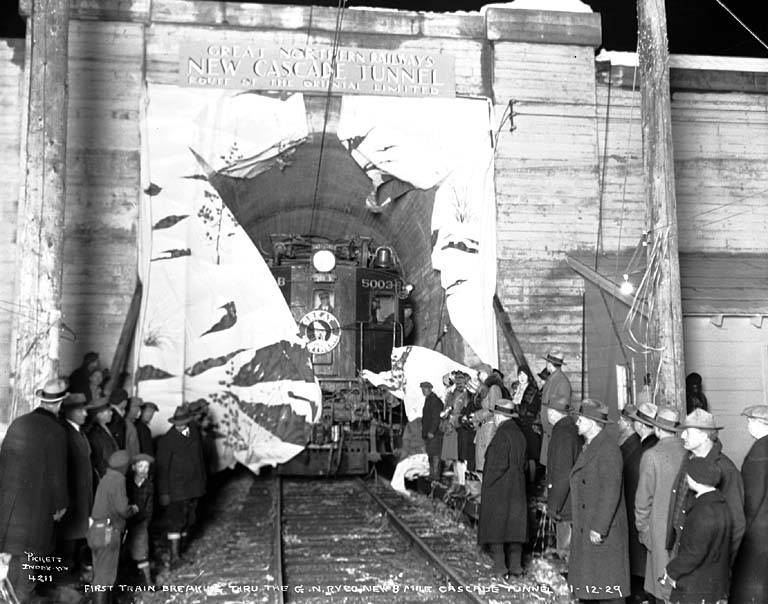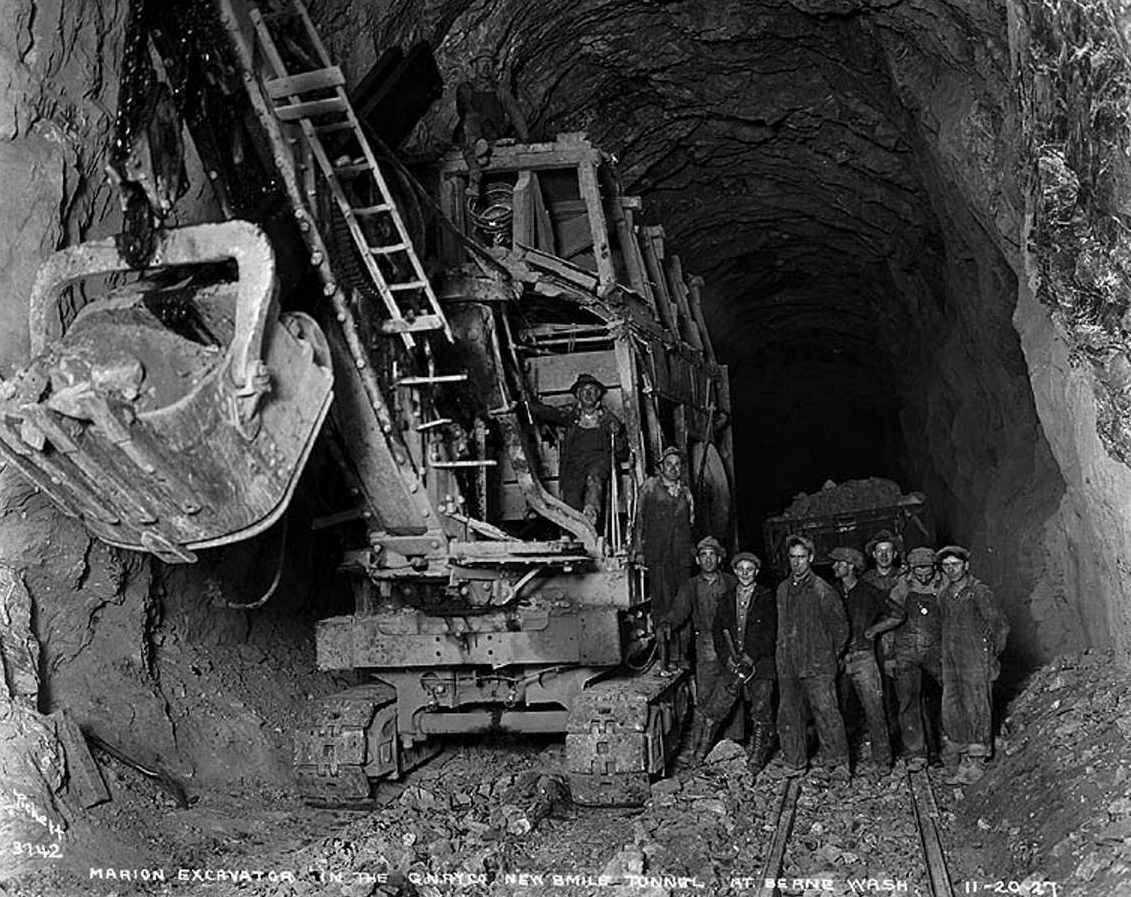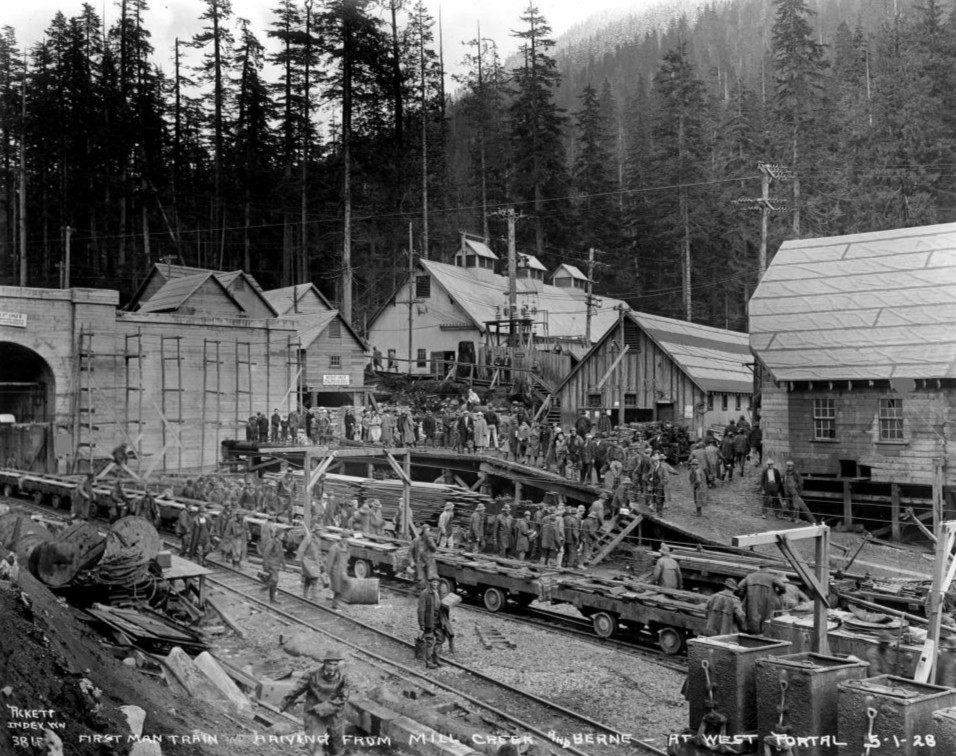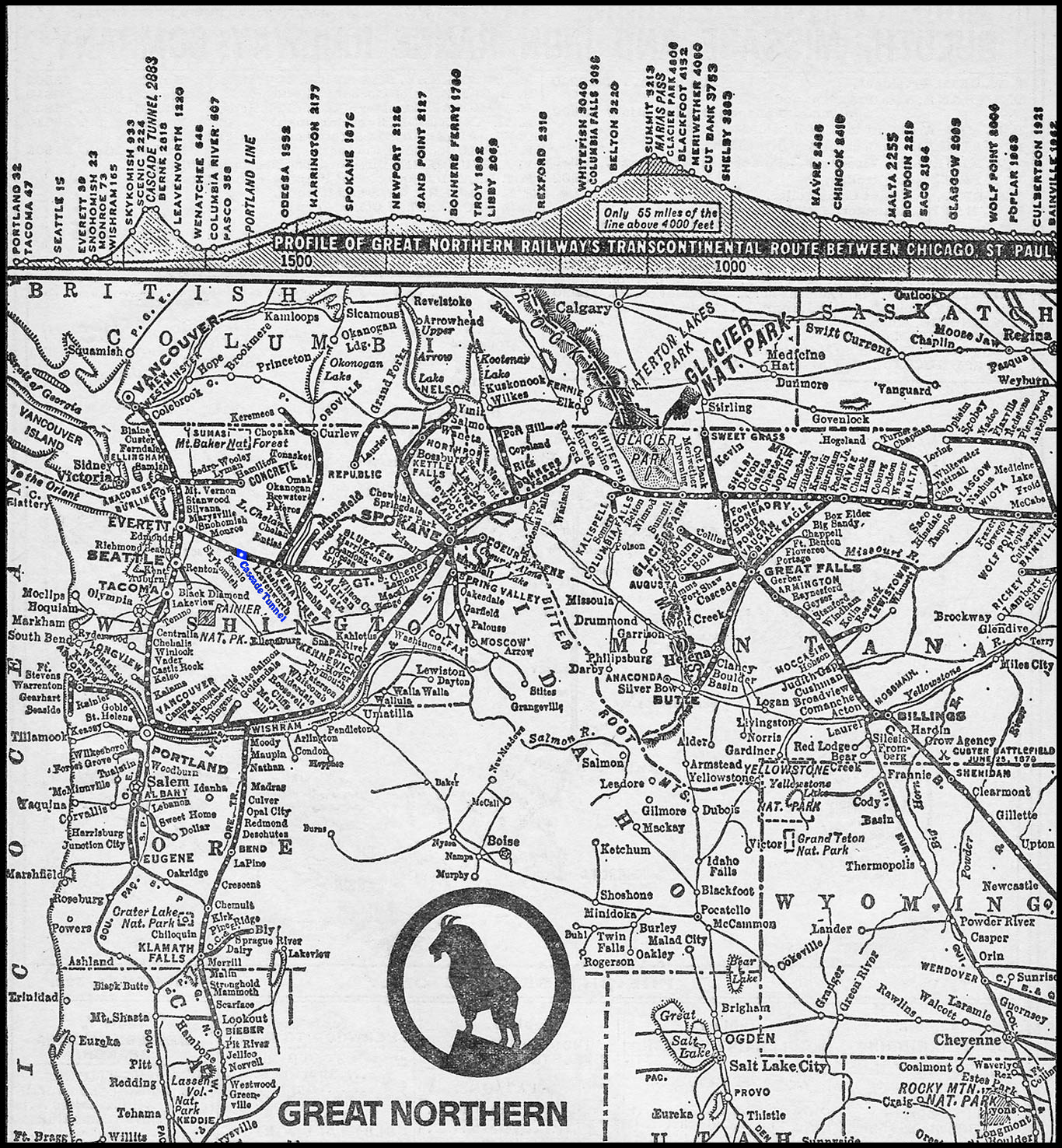Cascade Tunnel (Washington): Map, Avalanche, Ventilation
Last revised: August 24, 2024
By: Adam Burns
The Great Northern Railway, an esteemed titan in the North American rail transportation industry, was the proud owner of the Cascade Tunnel.
Known for their significant contribution to expanding the railway grid across northwestern U.S., the railway company's inception of the tunnel underpinned its commitment to innovation and progressivism.
Cascade Tunnel, also known as the Stevens Pass Tunnel, is actually the second structure to be built through the mountain, replacing the original in the late 1920s.
At nearly eight miles in length it is one of the longest railroad tunnel ever built and remains in operation today by successor BNSF Railway as part of its transcontinental main line connecting Seattle and Chicago.
For roughly 25 years the tunnel was electrified by GN but this was discontinued in the mid-1950s when conventional diesels took over.
Due to the tunnel's length it has a rather problematic handicap, even today, of requiring ventilation of the shaft for up to 45 minutes.
As a result, Cascade is somewhat of a bottleneck on the BNSF system. Of all the railroads James Hill either owned or controlled in some way, the Great Northern Railway is by far his greatest masterpiece earning him the legendary nickname, Empire Builder.
Photos
History
Nestled within the mountains of Washington state, the Cascade Tunnel stands as an engineering marvel that revolutionized railway transport for the Great Northern Railway.
Construction of this momentous project began on January 12, 1925, a venture inspired by the need for a lower elevation, safer, and more efficient railway route through the treacherous Cascade Mountains.
At A Glance
After four years of arduous labor under challenging mountain terrain, the tunnel officially opened on January 12, 1929. This milestone marked a significant advancement in the railway industry, providing safer and more efficient transit for goods and passengers alike.
Astoundingly, the construction of the Cascade Tunnel was a costly endeavor — the total expenditure amounting to a staggering $25.6 million.
Given the inflation rates and economic contexts of the 1920s, this represented a monumental investment, indicative of the tunnel's importance and anticipated potential.
The total cost for both the construction and ongoing maintenance of the Cascade Tunnel was significant. Coupled with the $25 million construction cost were untold millions spent over decades on its upkeep, making it one of the most expensive railway projects of its time.
Original Tunnel
The original tunnel began construction in the late summer of 1897 and took more than three years to complete; the bore opened just prior to the Christmas of 1900. Only July 10, 1909 GN further improved the tunnel by completing a short, 6,600-volt 25 Hz three-phase AC electrification system to eliminate asphyxiation issues caused by steam locomotives.
While the original tunnel still sat at a very high elevation of nearly 3,383 feet it eliminated a hellish grouping of switchbacks required to scale Stevens Pass, totaling more than eight miles in length.
This setup was not only a major issue due to the steep grades but also unrelenting snowfalls could bury trains for days.
During one such incident in 1910 an avalanche toppled a passenger train waiting to be dug out, killing nearly 100 souls. The accident is chronicled in Martin Burwash's book Vis Major listed below.
While the original 2.6-mile long tunnel improved railroad operations by reducing grades to between 1.7% and 2.2%, it still sat high on the mountain within range of punishing Cascade blizzards.
Following the avalanche disaster at Wellington, Washington the GN was forced to find a better route over the
mountain.
In 1925 the railroad began construction on a new Cascade Tunnel, located about 500 feet down the mountainside. For the most part this tunnel sat away from the worst of the mountain's winters being located below the highest elevations.
The tunnel is situated in the beautiful county of King, Washington state. The western portal is near the unincorporated community of Scenic, while the eastern portal located near Berne, at the base of Stevens Pass in the Cascade Mountain range.
Testifying to its engineering prowess, Cascade is an impressive 7.8 miles long, making it the longest railway tunnel in the United States. In its time, it was also the longest tunnel of its kind in the world, announcing America's standing in the realm of railway engineering.
The ruling grade is a manageable 1.7 percent. This relatively gradual grade permits trains to traverse through the mountainous terrain effortlessly, ensuring safe and efficient cargo and passenger transportation.
Location
Electrification
The extraordinary length forced the Great Northern to electrify the tunnel to avoid fumigation issues, caused by operating steam locomotives. Prior to the new bore's completion, GN updated its electrification to a modern, 11,000-volt, 25 Hz AC monophase system.
It was finished in 1928 and ran a length of 73 miles between Skykomish and Wenatchee. Electrification was provided by Puget Sound Power and Light Company, which constructed new power plants at Wenatchee and Skykomish that supplied 7,500 kilowatts of power to the railroad.
In addition, GN built new shops at the Appleyard Terminal in South Wenatchee to maintain its fleet of electrics. The electrification continued until January, 1956 when the system was shutdown in favor of diesels.
Today, Cascade is equipped with a unique ventilation system to manage the hazardous exhaust fumes from diesel locomotives. Originally relying on natural drafts, the tunnel now employs powerful fans at the eastern end, which operate between trains to expel exhaust and draw in fresh air, maintaining the tunnel's air quality.
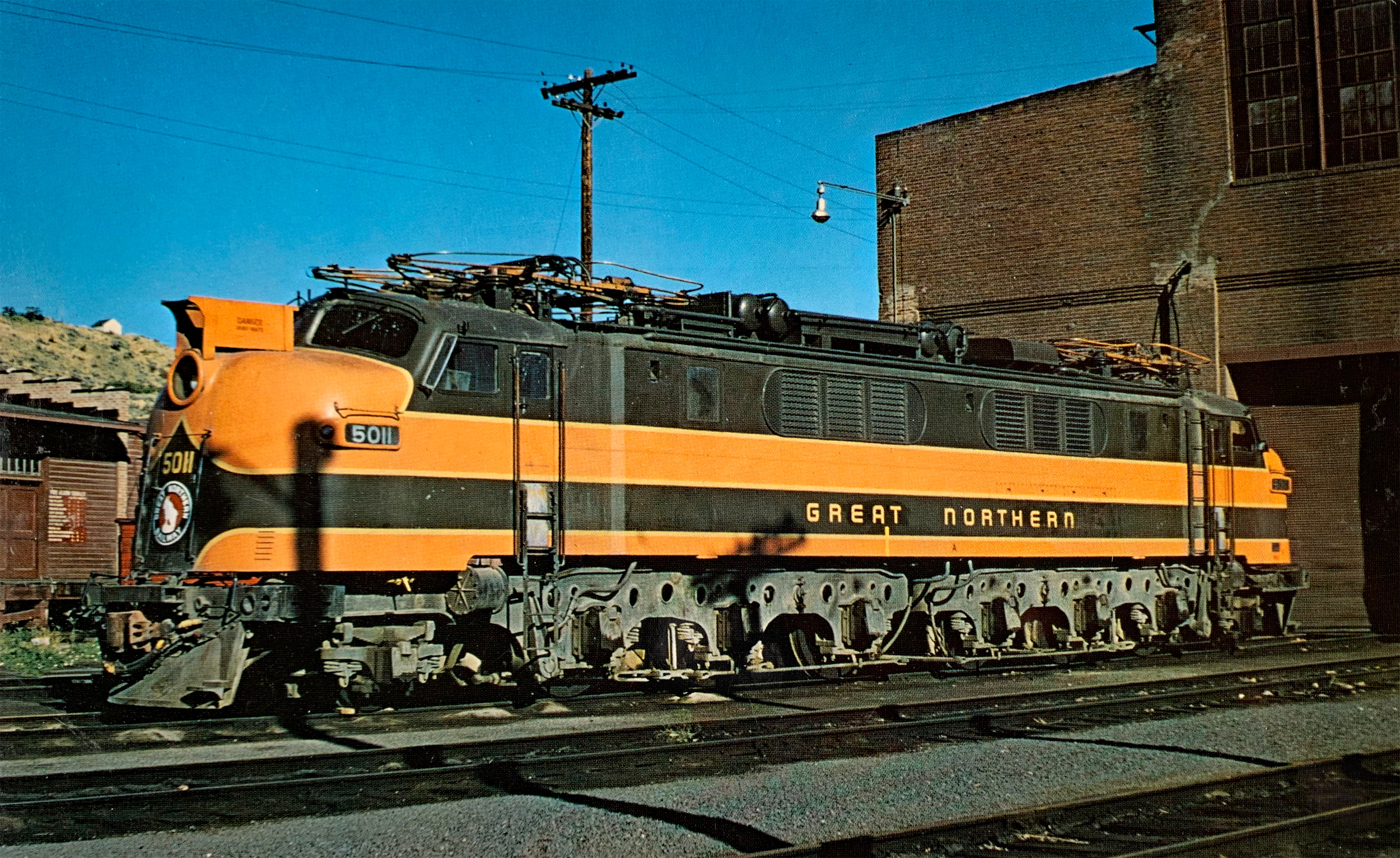 Great Northern 1-C+C-1 #5011 (Class Y) was already retired when photographed here by Stan Kistler at Wenatchee, Washington on July 5, 1957. The 3,000 horsepower unit was originally completed as a boxcab by General Electric/Alco in 1927. It was involved in a derailment during World War II while leading the "Fast Mail" and completely destroyed. GN shop forces managed to salvage the running gear and frame and rebuilt the unit using FT cab ends acquired from Electro-Motive. After retirement she was acquired by the Pennsylvania Railroad as a parts source for the other Class Y's the PRR had purchased for use in freight service between Philadelphia - Enola - Baltimore. Author's collection.
Great Northern 1-C+C-1 #5011 (Class Y) was already retired when photographed here by Stan Kistler at Wenatchee, Washington on July 5, 1957. The 3,000 horsepower unit was originally completed as a boxcab by General Electric/Alco in 1927. It was involved in a derailment during World War II while leading the "Fast Mail" and completely destroyed. GN shop forces managed to salvage the running gear and frame and rebuilt the unit using FT cab ends acquired from Electro-Motive. After retirement she was acquired by the Pennsylvania Railroad as a parts source for the other Class Y's the PRR had purchased for use in freight service between Philadelphia - Enola - Baltimore. Author's collection.Interestingly, this ventilation system proved to be more difficult to operate than originally expected; fumigation problems haunted the railroad and
its successor, Burlington Northern, not only because of the tunnel's
length but also due to the grade, about 1.7% from west to east.
The first ventilation systems took up to, if not more than, an hour to clear the tunnel of fumes before another train was allowed to enter. Additionally, crews were required to wear, or at least with them, respirators in the event of a ventilation failure as it usually took a train a full hour to scale the tunnel.
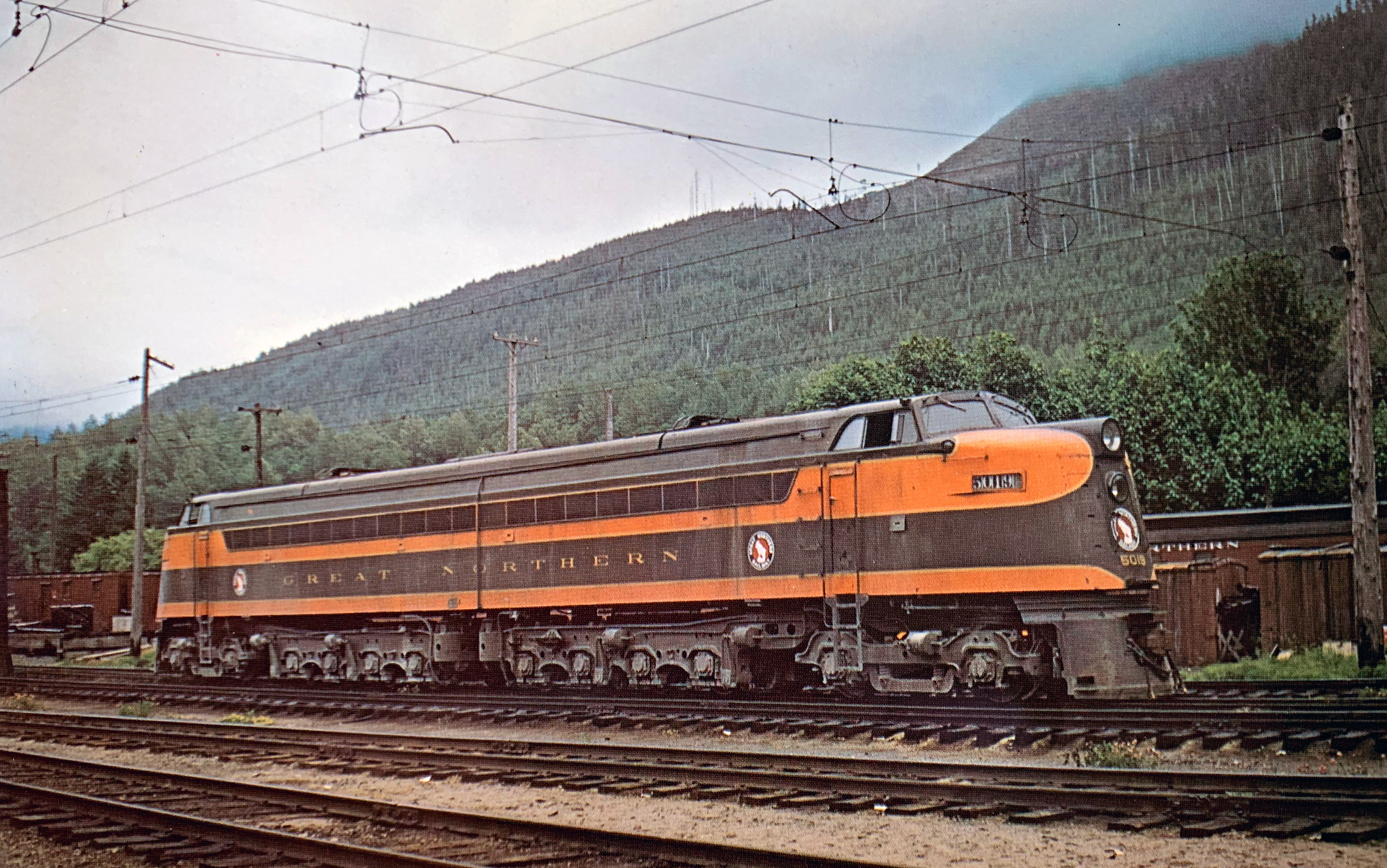 Great Northern B-D+D-B electric #5019 (Class W-1) is seen here between assignments at Skykomish, Washington on June 9, 1956. Capable of producing 5,000 continuous horsepower (6,000 starting) the big electric (and sister #5018), built by Alco/General Electric in 1947, saw less than ten years of service before GN turned off the electricity through 7.8-mile Cascade Tunnel in August, 1956. Stan Kistler photo. Author's collection.
Great Northern B-D+D-B electric #5019 (Class W-1) is seen here between assignments at Skykomish, Washington on June 9, 1956. Capable of producing 5,000 continuous horsepower (6,000 starting) the big electric (and sister #5018), built by Alco/General Electric in 1947, saw less than ten years of service before GN turned off the electricity through 7.8-mile Cascade Tunnel in August, 1956. Stan Kistler photo. Author's collection.Today
Today, owner BNSF Railway has installed a ventilation system capable of removing exhaust within 20 minutes although crews are still required to have respirators with them at all times.
For an idea of just how bad it could be for crewmen operating through tunnel please read this account by John Crosby who worked this segment of the line during the Burlington Northern era.
Train speeds today for BNSF freights and Amtrak passenger trains are held to 25 mph. One still has to wonder, however, why Burlington Northern did not exercise its ownership of nearby Snoqualmie Tunnel after the Milwaukee Road abandoned its main line through this region in 1980.
Using that bore, which was the best engineered tunnel across the Cascade range, would have saved BN and BNSF millions in maintenance costs and liability.
Legacy
Given its impressive length, constructing the Cascade Tunnel was no ordinary feat. The project demanded advanced engineering techniques, sturdy machinery, and a sizable and dedicated workforce who toiled in difficult conditions to bring this ambitious project to fruition.
The decision to drill a tunnel of this magnitude through the Cascade Mountains was driven by necessity. The Great Northern Railway's existing route over Stevens Pass was perilous, particularly during the harsh winter months when avalanches posed significant threats.
The safer, lower elevation route through the Cascade Tunnel offered a solution, forever changing the way cargo and passengers transited the treacherous Cascade ranges.
Despite its significant initial cost and ongoing maintenance expenses, the Cascade Tunnel proved an excellent investment for the Great Northern Railway, allowing for consistent, year-round operation. It greatly enhanced the railway's efficiency, providing a more reliable route for goods and passenger traffic.
Over the decades, the Cascade Tunnel has undergone numerous upgrades and modifications. The original wooden interior was replaced with concrete lining, electrical systems were updated, and ventilation techniques improved, ensuring the tunnel's functionality in line with evolving railway technologies.
The electrification process employed in the Cascade Tunnel was an ambitious endeavor by the Great Northern Railway. Far ahead of its time, the overhead catenary system powered trains through the tunnel for nearly half a century.
The Cascade Tunnel's operational status today stands as a testament to its enduring robustness and relevance. Despite being nearly a century old, the tunnel continues to operate under the auspices of the BNSF Railway, attesting to its durability and significance.
In its time, the Cascade Tunnel saw various locomotives pass through it. From sturdy steam engines to efficient electric locomotives, and powerful diesel trains, the types of locomotives used reflected the evolution of rail transportation technology.
Today, the Cascade Tunnel remains a vital artery for freight transportation. Amid America's vast railway network, it ensures the smooth and efficient movement of goods over the Cascade Mountains, playing a crucial role in the national supply chain.
The tunnel stands not just as an architectural triumph but also a symbol of human grit, determination, and ingenuity. The many men who worked relentlessly to first conceive, design, and then construct this engineering marvel are a testament to the human spirit's resilience and inventiveness.
As a national asset, Cascade Tunnel showcases America's industrial prowess during the early 20th century. It records the country's epoch marked by significant industrial growth, the propagation of railway networks, and a nationwide commitment towards infrastructural development, progress, and expansion.
For historians and railroad enthusiasts, the Cascade Tunnel offers a wealth of information. It intertwines engineering prowess with human stories of perseverance, painting a comprehensive picture of the challenges and triumphs seen during the era of its construction.
Today, although goods trains constitute the bulk of its traffic, the Cascade Tunnel occasionally services passenger trains as well. It's an integral part of Amtrak's Empire Builder route, an experience that offers passengers a firsthand view of this historic tunnel.
Modern train control technology plays an indispensable role in keeping the Cascade Tunnel operational and efficient. Advanced signal systems, slide detection technologies, and electric door systems ensure the safe transit of trains through this enormous tunnel.
The Cascade Tunnel's climactic inclusion in various works of literature and film underscores its inspirational status and relevance. Its monumental struggle during construction and triumphant landmark status is a compelling narrative that continues to captivate audiences.
While Cascade Tunnel was relinquished of its title as the world's longest railway tunnel many years ago, its legacy has not diminished. It continues to inspire modern engineering feats, and its historical significance in American rail transportation remains unparalleled.
In an era of expanding and improving transportation infrastructures, the story of the Cascade Tunnel provides valuable lessons. It's a testament to the power of innovation, strategic planning, and focused execution, reminding us that challenges are not impediments, but catalysts toward progress.
From its conception, construction, and continuous operation, the Cascade Tunnel embodies a significant chapter in the history of railway transportation. And while it no longer holds the title of the world's longest tunnel, its enduring operation, advanced adaptations, and rich history underline the Cascade Tunnel's prominence on the pages of American railway history.
Sources
- Hidy, Ralph W., Hidy, Muriel E., Scott, Roy V., And Hofsommer, Don L. Great Northern Railway, The: A History. Minneapolis: University of Minnesota Press, 2004 edition.
- Kelly, John. Great Northern Railway: Route Of The Empire Builder. Hudson: Iconografix, 2013.
- Schafer, Mike. Classic American Railroads. Osceola: MBI Publishing, 1996.
Recent Articles
-
Alaska Beer Tasting Train Rides
Sep 30, 25 11:58 AM
The state's beer tasting experience is limited only to the Alaska Railroad, a seasonal event held each fall. -
Colorado ~Murder Mystery~ Dinner Train Rides
Sep 30, 25 09:33 AM
Nestled among the breathtaking vistas and rugged terrains of Colorado lies a unique fusion of theater, gastronomy, and travel—a murder mystery dinner train ride. -
Washington ~Murder Mystery~ Dinner Train Rides
Sep 30, 25 09:31 AM
This article delves into what makes murder mystery dinner train rides in Washington State such a captivating experience.

